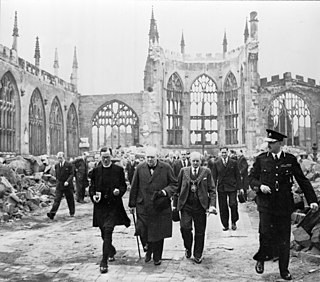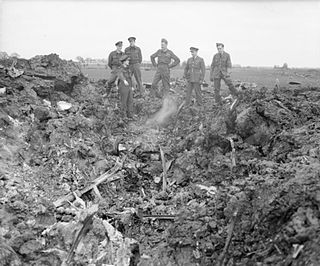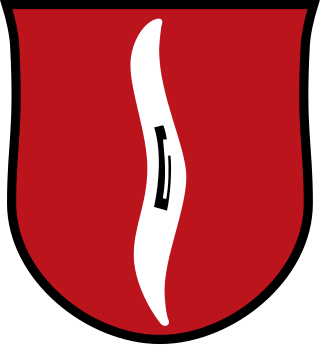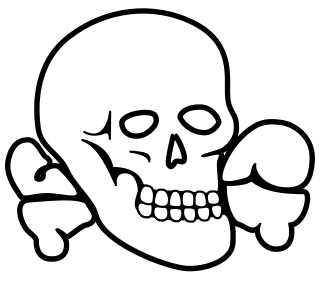
The Blitz was a German bombing campaign against the United Kingdom, in 1940 and 1941, during the Second World War. The term was first used by the British press and originated from the term Blitzkrieg, the German word meaning 'lightning war'.

Firebombing is a bombing technique designed to damage a target, generally an urban area, through the use of fire, caused by incendiary devices, rather than from the blast effect of large bombs. In popular usage, any act in which an incendiary device is used to initiate a fire is often described as a "firebombing".

The Heinkel He 111 is a German airliner and bomber designed by Siegfried and Walter Günter at Heinkel Flugzeugwerke in 1934. Through development, it was described as a "wolf in sheep's clothing". Due to restrictions placed on Germany after the First World War prohibiting bombers, it was presented solely as a civil airliner, although from conception the design was intended to provide the nascent Luftwaffe with a heavy bomber.

The Belfast Blitz consisted of three German air raids on strategic targets in the city of Belfast in Northern Ireland, in April and May 1941 during World War II, causing high casualties. The first was on the night of 7–8 April 1941, a small attack which probably took place only to test Belfast's defences. The next took place on Easter Tuesday, 15 April 1941, when 200 Luftwaffe bombers attacked military and manufacturing targets in the city of Belfast. Some 900 people died as a result of the bombing and 1,500 were injured. High explosive bombs predominated in this raid. Apart from those on London, this was the greatest loss of life in any night raid during the Blitz.

The Coventry Blitz, or Coventration of the city, was a series of bombing raids that took place on the British city of Coventry. The city was bombed many times during the Second World War by the German Air Force (Luftwaffe). The most devastating of these attacks occurred on the evening of 14 November 1940 and continued into the morning of 15 November.

The Bristol Blitz was the heavy bombing of Bristol, England by the Nazi German Luftwaffe during the Second World War. Due to the presence of Bristol Harbour and the Bristol Aeroplane Company, the city was a target for bombing and was easily found as enemy bombers were able to trace a course up the River Avon from Avonmouth using reflected moonlight on the waters, into the heart of the city. Bristol was the fifth-most heavily-bombed British city of the war.
Kampfgeschwader 55 "Greif" was a Luftwaffe bomber unit during World War II. KG 55 was one of the longest serving and well-known in the Luftwaffe. The wing operated the Heinkel He 111 exclusively until 1943, when only two staffeln of its four Gruppen (Groups) used the Junkers Ju 88C.

Operation Steinbock or Operation Capricorn, sometimes called the Baby Blitz, was a strategic bombing campaign by the German Air Force during the Second World War. It targeted southern England and lasted from January to May 1944. Steinbock was the last strategic air offensive by the German bomber arm during the conflict.

Kampfgeschwader 4 "General Wever" was a Luftwaffe bomber wing during World War II. The unit was formed in May 1939. The unit operated the Dornier Do 17, Junkers Ju 88 and Heinkel He 111 medium bombers, with later service on the Heinkel He 177 heavy bomber. The wing was named after General Walther Wever, the prime pre-war proponent for a strategic bombing capability for the Luftwaffe, who was killed in an aircraft accident in 1936.

Kampfgeschwader 3 "Blitz" (KG 3) was a Luftwaffe bomber wing during World War II.
Kampfgeschwader 51 "Edelweiss" (KG 51) was a Luftwaffe bomber wing during World War II.

Kampfgeschwader 76 was a Luftwaffe bomber Group during World War II. It was one of the few bomber groups that operated throughout the war.

Kampfgeschwader 54 "Totenkopf" was a Luftwaffe bomber wing during World War II. It served on nearly all the fronts in the European Theatre where the German Luftwaffe operated.
Lehrgeschwader 1 formerly Lehrgeschwader Greifswald was a Luftwaffe multi-purpose unit during World War II, operating fighter, bomber and dive-bomber Gruppen. The unit was formed in July 1936 and operated the Messerschmitt Bf 109, Messerschmitt Bf 110, Dornier Do 17, Heinkel He 111, Junkers Ju 88 and Junkers Ju 87.
Kampfgeschwader 77 was a Luftwaffe bomber wing during World War II. Its units participated on all of the major fronts in the European Theatre until its dissolution in 1944. It operated all three of the major German bomber types; the Dornier Do 17, Heinkel He 111 and the Junkers Ju 88.

Kampfgeschwader 26 "Löwengeschwader" was a German air force Luftwaffe bomber wing unit during World War II. Its units participated on all of the fronts in the European Theatre until the end of the war. It operated three of the major German aircraft medium bomber types; the Heinkel He 111, Junkers Ju 88 and the Junkers Ju 188. The unit engaged in both strategic bombing, close air support, anti-shipping and aerial interdiction operations. The majority of its operational life – not entirely unlike another Luftwaffe wing designated KG 40 — was spent on anti-shipping missions.

The Heinkel He 111 was one of the most numerous German bombers of the Second World War. Designed in the mid-1930s, the type persevered until 1945. In Spain, variants of the design saw service until 1973.

Kampfgeschwader 1 was a German medium bomber wing that operated in the Luftwaffe during World War II.

The Leeds Blitz comprised nine air raids on the city of Leeds by the Nazi German Luftwaffe. The heaviest raid took place on the night of 14/15 March 1941, affecting the city centre, Beeston, Bramley and Armley. The city was subjected to other raids during the Second World War, but they were relatively minor; only the March 1941 raid caused widespread damage, including to the city's museum and its artefacts.
Operation Crucible is a play by Kieran Knowles about the Sheffield Blitz, the German Luftwaffe bombing of Sheffield, England, during the Second World War. The drama focuses on a group of four (fictional) steelworkers trapped inside the cellar of the Marples Hotel, in the city's Fitzalan Square, which was destroyed during bombing on 12 December 1940.

















